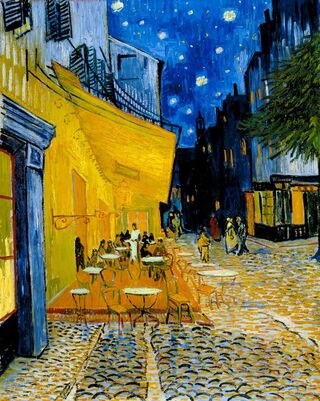Career
How Van Gogh’s “Hot Streak” Fits Some Universal Patterns
Hot streaks often involve broad exploration followed by laser-focused mastery.
Posted September 14, 2021 Reviewed by Abigail Fagan
Key points
- A hot streak is a universal phenomenon that occurs in many domains such as athletics, art, and science.
- The onset of a hot streak is often marked by transitioning from broad exploration to the exploitation of deep expertise, research suggests.
- Exploring new domains and then focusing on existing competencies can help people produce high-impact work.
In the realm of artistic, cultural, and scientific careers, a "hot streak" of creativity is loosely defined as a period of extraordinary peak performance marked by producing a cluster of high-impact works in close succession.
A few years ago, Dashun Wang and colleagues at Northwestern University's Kellogg School of Management developed a hot-streak model that allowed them to quantitatively probe this phenomenon based on the career histories of individual artists, film directors, and scientists. This paper (Liu et al., 2018) established that "hot streaks are ubiquitous" and "remarkably universal across diverse domains."
As a follow-up to these findings, Wang was inspired to investigate what triggers these bursts of high-impact work. His team's most recent paper (Liu et al., 2021) advances our understanding of what triggers the onset of hot streaks across artistic, cultural, and scientific careers. These findings were published on September 13 in Nature Communications.

Broad Exploration Quickly Followed by Laser-Focused Exploitation Facilitates Hot Streaks
During a visit to the Van Gogh Museum in Amsterdam, Wang had an epiphany that led to a new hypothesis: "Hot streaks result from years of exploration (studying diverse styles or topics) immediately followed by years of exploitation (focusing on a narrow area to develop deep expertise)."
"If you look at [Van Gogh's] production before 1888, it was all over the place. It was full of still-life paintings, pencil drawings, and portraits that are much different in character from the work he created during his hot streak," Wang explains in a September 2021 news release.
"Van Gogh experienced an artistic breakthrough from 1888-1890, during which he painted his most famous works," Wang notes. "Before that, however, his work was less impressionistic and more realistic. [Van Gogh] also tended to use somber earth tones rather than the bright, sweeping colors, for which he is best known today."
During the first cluster of Vincent van Gogh's legendary hot streak, he lived in the provençal town of Arles, where he created masterpieces such as "Café Terrace at Night" and "Sunflowers in a Vase." From early 1888 to mid-1889 (the artist's Arles period), he produced 187 paintings.
During the year Van Gogh spent in an asylum, from May 1889 to May 1990, he created another brilliant cluster of 142 artworks. Despite serious mental health issues, Van Gogh's cluster of high-impact productivity at the Saint-Rémy de Provence asylum resulted in breathtaking paintings such as "The Starry Night" and "Self-Portrait with Bandaged Ear."
In addition to analyzing the onset of Van Gogh's hot streak in the 1800s, the researchers used deep-learning algorithms and network science to mine data from 800,000 visual arts images that covered the career histories of 2,128 artists, including Jackson Pollock.
In Pollock's case, the researchers found that after many years of exploration and experimentation with a wide range of styles, there was a three-year hot streak (1947-1950) when the artist mastered and exploited his famous "drip technique" that broke away from conformity.
To analyze what led to film directors' hot streaks, Wang and his team mined data from the Internet Movie Database (IMDb) about 79,000 films by 4,337 directors.
To deconstruct the onset of hot streaks in science, the researchers analyzed 20,040 scientist's career histories by combining publication and citation datasets from Google Scholar and the Web of Science. According to the news release, "Wang and his collaborators quantified a hot streak within each career based on the impact of works produced, measured by auction price, IMDB ratings, and academic paper citations."
Some timeless and universal patterns emerged in each of these domains. "We find that across all three domains, individuals tend to explore diverse styles or topics before their hot streak, but become notably more focused after the hot streak begins," the authors explain.
Balancing Experimentation and Implementation Is a Winning Formula
"We were able to identify among the first regularities underlying the onset of hot streaks, which appears universal across diverse creative domains," Wang said. "Our findings suggest that creative strategies that balance experimentation with implementation may be especially powerful."
Interestingly, if a period of exploration, openness, and experimentation isn't followed by exploiting a trademark style, the odds of having a hot streak appear to be significantly reduced. Similarly, when exploitation of a narrowly-focused approach isn't preceded by diverse exploration, hot streaks also seem to be less common.
The magic formula for triggering the onset of a hot streak seems to be when exploration is closely followed by exploitation. "Neither exploration nor exploitation alone in isolation is associated with a hot streak. It's the sequence of them together," Wang notes.
"This knowledge can help individuals and organizations understand the different types of activities to engage in—such as exploring new domains or exploiting existing knowledge and competencies—and the optimal sequence to use in order to achieve the most significant impact," co-author Jillian Chown concludes.
References
Lu Liu, Nima Dehmamy, Jillian Chown, C. Lee Giles & Dashun Wang. "Understanding the Onset of Hot Streaks Across Artistic, Cultural, and Scientific Careers." Nature Communications (First published: September 13, 2021) DOI: 10.1038/s41467-021-25477-8
Lu Liu, Yang Wang, Roberta Sinatra, C. Lee Giles, Chaoming Song & Dashun Wang. "Hot Streaks in Artistic, Cultural, and Scientific Careers." Nature (First published: July 11, 2018) DOI: 10.1038/s41586-018-0315-8




